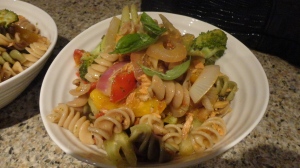 I don’t buy store bread, typically, except the occasional pitas or wraps. I make bread once a week and that’s more than enough for the two of us, even if we have dinner guests. Lately, I’ve really been on a sourdough kick – inspired by Michael Pollan’s Cooked.
I don’t buy store bread, typically, except the occasional pitas or wraps. I make bread once a week and that’s more than enough for the two of us, even if we have dinner guests. Lately, I’ve really been on a sourdough kick – inspired by Michael Pollan’s Cooked.
The idea of bread that rises without the use of commercial yeast appeals to a person like me, who loves inventing things, and wanted to grow up to be an astronaut. Combine that with my search for the perfect technique that combines my commitment to using as much whole-grain flour as possible, with getting great crust, a moist interior, and that elusive “spring” where the interior forces itself through the slash as it bakes in the oven, and you can imagine lots of sourdough-baking in my future.
Unlike the precision of, say, cake baking, sourdough isn’t so much a recipe as a science experiment (albeit a tasty one). I don’t typically use a recipe so much as check out other bakers’ successful tips and then work at adapting it until it feels right. I’ve used different versions, but for starters I would suggest you check out Anne Marie’s (the Zero Waste Chef). Check out her other incredible, helpful, and sometimes edible posts, also.
You might also like the post specially-designed for beginners from The Perfect Loaf. He has many, many versions of sourdough – which makes me slightly fearful of my eventual fate, having embarked on this journey.
The most interesting thing I’ve noted is that both the examples provided by these excellent bakers seemed lately to be unduly wet. Sourdough afficionados will tell you the dough should be wet, but I’m talking ridiculously wet, almost like soup. Yet it didn’t start out that way at the autolyse stage, nor during the folding. It seemed to happen during the bulk fermentation. What I’ve realized is that, being a typical Toronto summer, it is much more humid than it was in the spring, and definitely more than the winter. So I think the dough is absorbing more moisture from the air. The other day it was 60% humidity inside, with the air conditioning turned on. So I’m learning to adjust for that.
Anyway, each loaf has turned out very well, some better than others. This pair of loaves have been a real treat, as you can see! I hope you’ll share your favourite way to use sourdough bread.





